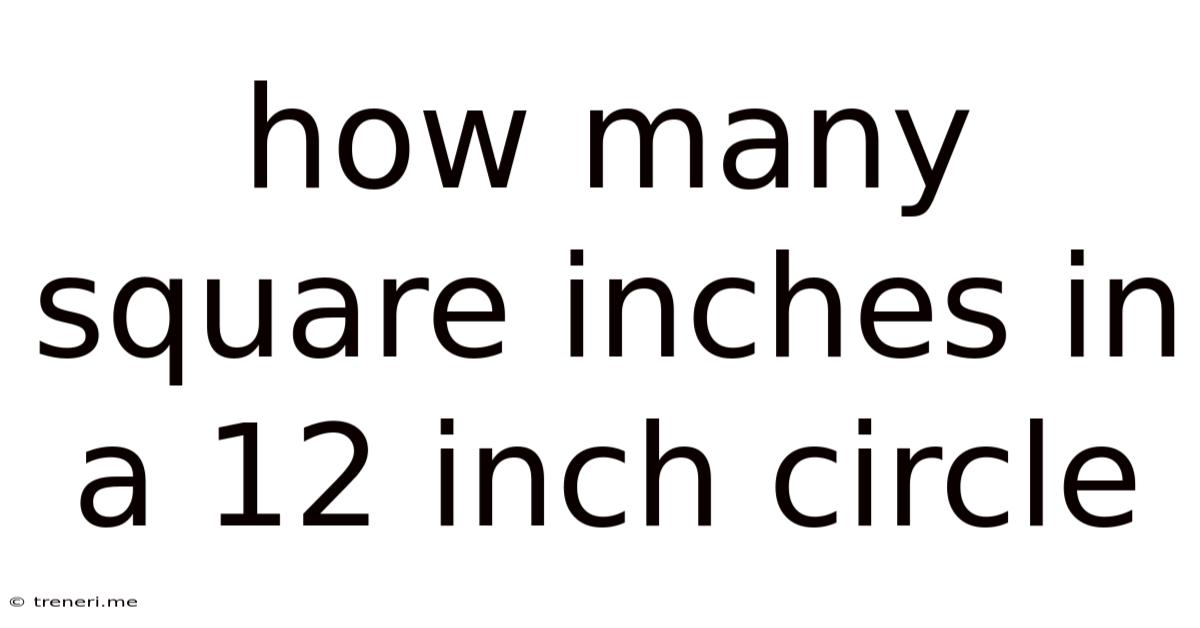How Many Square Inches In A 12 Inch Circle
Treneri
May 12, 2025 · 4 min read

Table of Contents
How Many Square Inches in a 12-Inch Circle? Understanding Area Calculation
Determining the area of a circle is a fundamental concept in geometry with practical applications across various fields. This article delves into the calculation of the area of a 12-inch circle, explaining the process step-by-step and exploring related concepts. We'll also discuss common misconceptions and provide practical examples to solidify your understanding.
Understanding the Formula: Pi (π) and Radius
The area of a circle is calculated using the formula: Area = πr², where:
-
π (Pi): A mathematical constant representing the ratio of a circle's circumference to its diameter. It's approximately equal to 3.14159. For practical purposes, using 3.14 is often sufficient, but calculators usually provide a more precise value.
-
r (Radius): The distance from the center of the circle to any point on its circumference. In a 12-inch diameter circle, the radius is half the diameter, meaning r = 6 inches.
Calculating the Area of a 12-Inch Circle
Now, let's apply the formula to calculate the area of our 12-inch circle:
-
Identify the radius: The diameter is 12 inches, so the radius (r) is 12 inches / 2 = 6 inches.
-
Square the radius: r² = 6 inches * 6 inches = 36 square inches.
-
Multiply by Pi (π): Area = π * 36 square inches. Using π ≈ 3.14159, we get:
Area ≈ 3.14159 * 36 square inches ≈ 113.097 square inches.
Therefore, a circle with a 12-inch diameter has an area of approximately 113.097 square inches. Rounding to the nearest tenth, we can say it's approximately 113.1 square inches.
Common Misconceptions and Clarifications
A frequent mistake is confusing the area (measured in square units) with the circumference (measured in linear units). The circumference is the distance around the circle, calculated using the formula Circumference = 2πr. While both formulas involve π and the radius, they represent entirely different aspects of the circle.
Another common error is incorrectly squaring the diameter instead of the radius. Remember, the formula uses the radius squared (r²), not the diameter squared (d²).
Practical Applications of Area Calculation
Understanding how to calculate the area of a circle is crucial in various fields:
- Engineering and Design: Calculating the area of circular components in machinery, piping systems, or architectural designs.
- Construction: Determining the amount of material needed to cover circular areas, such as floors or roofs.
- Manufacturing: Calculating the surface area of circular products or components.
- Agriculture: Determining the area of circular irrigation systems or planting areas.
- Real Estate: Estimating the area of circular land plots.
- Science: Calculating the cross-sectional area of pipes, cylinders, or other circular objects in physics and chemistry.
Beyond the Basics: Exploring Related Concepts
While calculating the area of a simple 12-inch circle is straightforward, several related concepts build upon this fundamental understanding:
1. Area of Sectors and Segments
A sector is a portion of a circle enclosed by two radii and an arc. A segment is the area between a chord and an arc. Calculating these areas requires adjusting the basic circle area formula based on the angle of the sector or the length of the chord.
2. Circles Inscribed in and Circumscribed Around Other Shapes
Circles can be inscribed within (touching all sides) or circumscribed around (passing through all vertices) other geometric shapes like squares, triangles, or polygons. Calculating the area of the circle in these scenarios often involves applying geometrical relationships to find the circle's radius.
3. Annulus Area
An annulus is the region between two concentric circles (circles with the same center). The area of an annulus is simply the difference between the areas of the larger and smaller circles.
4. Applications in Calculus
Calculating areas of irregular shapes involving circular components frequently utilizes integral calculus. The basic circle area formula serves as a foundation for these more complex calculations.
Improving Your Understanding: Practice Problems
To solidify your understanding, try calculating the areas of the following circles:
- A circle with a radius of 5 inches.
- A circle with a diameter of 18 inches.
- A circle with a circumference of 25 inches (you'll need to first find the radius using the circumference formula).
Conclusion: Master the Circle Area Calculation
Calculating the area of a circle, particularly a 12-inch circle as explored in this article, is a fundamental skill with widespread applicability. Understanding the formula, common errors to avoid, and related concepts will greatly enhance your problem-solving capabilities in various mathematical and real-world scenarios. By mastering this seemingly simple calculation, you unlock a powerful tool for addressing a wide range of geometrical challenges. Remember to always double-check your calculations and utilize the appropriate precision based on the context of your problem. Practice makes perfect, so continue exploring and applying this knowledge to build your confidence and proficiency.
Latest Posts
Latest Posts
-
60 Days After October 16 2024
May 15, 2025
-
Highest Common Factor Of 24 And 45
May 15, 2025
-
How Many Day Till June 14
May 15, 2025
-
0 6288 Rounded To The Nearest Hundredth
May 15, 2025
-
What Is 70 30 Body Shape
May 15, 2025
Related Post
Thank you for visiting our website which covers about How Many Square Inches In A 12 Inch Circle . We hope the information provided has been useful to you. Feel free to contact us if you have any questions or need further assistance. See you next time and don't miss to bookmark.